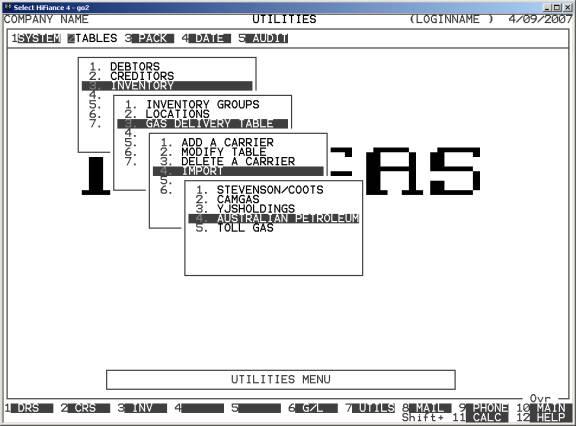HiFinance 4
SECTION 7.2.3.2.4 - IMPORT A
GAS MILK-RUN
USAGE: To import the information
supplied by the Carrier to be applied to the Debtor and Creditor Master files.
This program is only relevant for those sites that us the Fuels option.
DISCUSSION: This program is Carrier
specific. The file layout can be different each Carrier because each Carrier
uses a separate program. The screen displays a list of defined Carriers for
whom an import program exists. Typically, the screen will look as follows:

When you start the program, HiFinance checks for the
import file. The name depends on the Carrier. The file is always expected in
the normal data directory (eg h:\hf4data\ifa). If no file is found, an
error is displayed and the program returns you to the menu.
Currently, the file names for import are:
STEVENSON/COOTS................ stevo.dat
YJSHOLDINGS............................. yjshold.dat
AUST.PETROLEUM VIC............ austpet.dat
AUST.PETROLEUM SA............. auspetsa.dat
TOLL GAS..................................... toll.dat
IFATRANSPORT.......................... ifatas.dat
As most import procedures use fixed length records, it is imperative that you make sure that the file matches the correct file layout, for that Carrier. If you do not, incorrect entries will result.
If a file of the correct name is found, HiFinance
will attempt to interpret the file. The file will be read and each record will
be tested to make sure that the Debtor exists and that the Carrier code is
valid. When this is complete, you are asked to confirm that you wish to start
updating. If you answer YES, the file will be read in
again, however, this time the information will be used to update the various
files. When complete, you will be returned to the menu.
Files updated by each line in the Import program:
Debtor
master-file: The total of the sales and
cost-of-sales is posted to the Debtor’s record. In the case of a
Debtor/sub-account relationship, the outstanding balance is posted to the
parent account only. However the sales are posted to the actual Debtor, which
might be the parent or sub-account.
Debtor
Group file: The totals posted to the
Debtor will also update the Debtor Group totals.
Salesman
master-file: Total sales and
cost-of-sales are posted to the Salesman.
Debtor
transaction file: An Invoice
transaction is created for each Debtor.
Creditor
master-file: The total of the Carrier
fees is posted to the Carrier Creditor.
Creditor
Group file: The totals posted to the
Creditors will also update the Creditor Group totals.
Purchase
Order file: The Fuel Purchase is actually
created as a Purchase Order so that it can be reconciled with the Invoice from
the Supplier.
Debtor
transaction file: A Purchase
transaction is created for each Creditor.
Inventory
Master-file: Each line will create a
Purchase and Sale in the Inventory. This is posted to the totals for LPG. As
well as this, the Purchase Order will reflect in the On-Purchase Order total in
Inventory.
Inventory
Group file: Any totals updated in the
Inventory master-file will be reflected in the Group file.
Inventory
transaction-file: Each line will
create a Purchase and Sale in the Inventory. Each transaction will create an
appropriate transaction.
General
Ledger master-file: Each import line will
update the Trade Debtors, Sales, Cost-of-sales, Trade Creditors, Stock-on-Hand
and GST accounts.
General
Ledger transaction-file: Each General
Ledger master-file update will create a matching transaction. These accounts
must be defined in the GENERAL LEDGER
CONTROL ACCOUNTS.